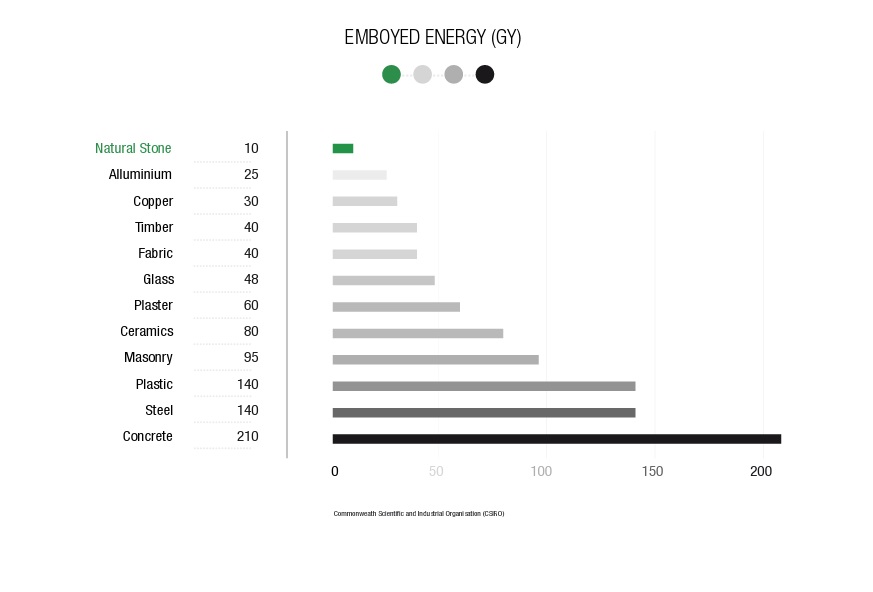Granite as a Building Material – Not Just Beautiful, Sustainable Too
In the world of construction, the choice of building materials holds significant importance not just in terms of structural strength and aesthetics but also regarding environmental impact. In recent years, there has been a growing awareness and emphasis on sustainability in construction practices. Among the many materials used, natural stone, particularly granite, has emerged as a sustainable and eco-friendly option, notably due to its low grey energy footprint.
Before delving into the sustainable aspects of granite, it’s crucial to understand what grey energy is and why it matters in construction. Grey energy, also known as embodied energy, refers to the total energy consumed throughout the life of a material. This includes energy used in extraction, processing, transportation, installation, maintenance, and eventual disposal or recycling. Calculating grey energy provides a comprehensive view of a material’s environmental impact, encompassing both direct and indirect energy consumption.
Granite Vs Engineered Stone: A Grey Energy Consumption Comparison
When comparing granite to engineered stones like quartz or marble, the difference in grey energy consumption becomes starkly evident. Studies conducted by reputable organizations have shown that granite possesses a significantly lower grey energy footprint. For instance, while granite typically has a grey energy value of around 33.3 MJ/m³, engineered stones can range from 100 to 200 MJ/m³ or higher, depending on their manufacturing processes and materials used.
In addition to sustainability issues, the manufacture of engineered stones also increases the risk of Silicosis amongst workers in the industry. The health risks associated with silicosis in the engineered stone industry is so high that countries have begun to pass legislature against it. Australia for example became the first country to prohibit the use, supply and manufacture of all engineered stone, starting in 2024.
This substantial difference underscores the sustainability of granite as a building material. Its lower grey energy consumption translates to reduced environmental impact across its entire lifecycle, making it a preferred choice for eco-conscious construction projects.
The Sustainable Advantages of Granite:
- Abundance and Longevity: Granite is a naturally abundant material found in various regions worldwide. Its durability and resistance to wear and tear ensure longevity, reducing the need for frequent replacements and associated energy costs. This longevity contributes significantly to its overall sustainability.
- Minimal Processing Requirements: Unlike engineered stones that often require extensive processing involving resins, additives, and energy-intensive manufacturing techniques, granite typically undergoes minimal processing after extraction. This simplicity in processing not only reduces grey energy but also minimizes waste generation and environmental impact.
- Energy-Efficient Extraction Practices: Modern quarrying practices for granite have become increasingly energy-efficient and environmentally conscious. Technologies such as diamond wire saws and water recycling systems help minimize energy consumption and waste generation during the extraction process, further enhancing granite’s sustainability credentials.
- Recyclability and Reusability: Granite is a highly recyclable material. Waste granite from quarries can be crushed and used as aggregates in concrete or road construction, promoting circular economy principles and reducing the demand for new materials. Additionally, granite can be reused in various applications, further extending its lifecycle and reducing environmental strain. Granite slurry for example can be used as an ingredient in the manufacture of compressed bricks.
- Aesthetic Appeal and Timelessness: Apart from its sustainability attributes, granite is renowned for its natural beauty, durability, and timeless elegance. Its unique variations in color and pattern add character to buildings, enhancing their visual appeal and contributing to a sustainable yet aesthetically pleasing environment.
In an era where environmental consciousness is at an all-time high, the construction industry is increasingly embracing sustainable practices and materials. By prioritizing materials like granite with lower grey energy footprints and inherent eco-friendly characteristics, construction projects can significantly reduce their environmental impact while ensuring structural integrity and visual appeal.
Educating stakeholders, including architects, builders, and consumers, about the benefits of sustainable materials like granite is essential in fostering a culture of environmental responsibility in construction. Governments and regulatory bodies can also play a vital role by incentivizing and promoting the use of sustainable materials through policies and certifications.
Granite’s sustainable brilliance in construction lies not only in its lower grey energy footprint but also in its abundance, durability, minimal processing requirements, energy-efficient extraction practices, recyclability, and timeless aesthetic appeal. As the construction industry continues to progress towards sustainability, embracing materials like granite paves the way for the development of more sustainable environments.
